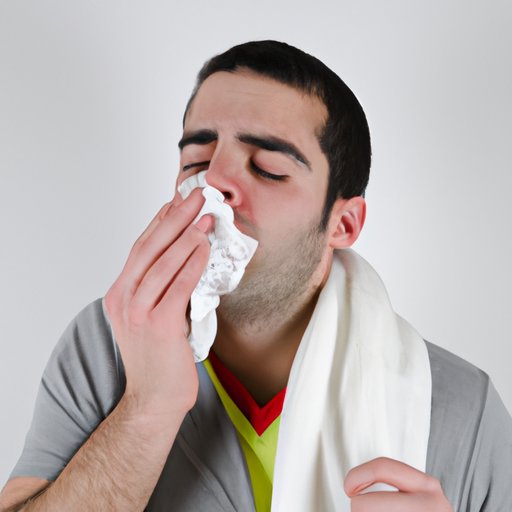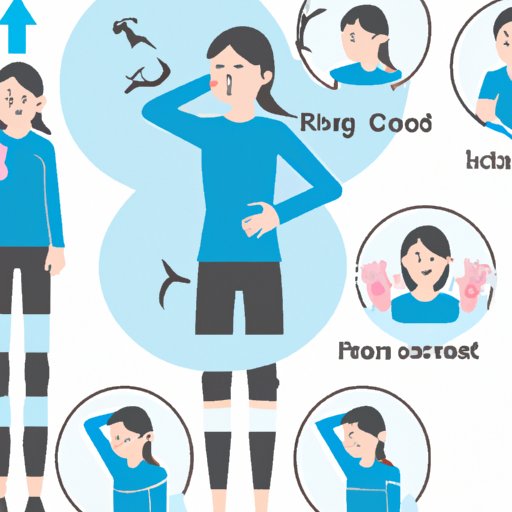Introduction
A “cold” is a common illness that affects millions of people every year. It is caused by a virus and typically includes symptoms such as a sore throat, runny nose, coughing, headache, fatigue, and fever. While there is no cure for the common cold, there are ways to alleviate its symptoms.
In this article, we’ll explore the effects of exercise on colds and whether or not working out can help reduce the severity of cold symptoms. We’ll look at how exercise can strengthen the immune system and its positive effects on overall health, as well as examine the scientific evidence behind exercise and colds. We’ll also analyze the pros and cons of exercising while sick and discover how different types of exercise can be used to help treat a cold.

Exploring the Benefits of Exercise for Fighting off a Cold
Regular exercise is one of the best ways to stay healthy and prevent the onset of diseases. Exercise helps the body maintain a healthy weight, improve cardiovascular health, and strengthen the muscles and bones. In addition, regular physical activity can boost the immune system, making it more efficient at fighting off infections.
The immune system works to protect the body from viruses and other foreign invaders. When the immune system is strong, it can quickly identify and respond to invading pathogens and prevent them from causing illness. Regular exercise can help keep the immune system functioning at its best by increasing circulation and improving the body’s ability to fight off infection.
Examining the Science Behind Working Out and Treating Colds
While there is still much to learn about the connection between exercise and colds, there is some scientific evidence that suggests that regular physical activity can help reduce the severity of cold symptoms. A study conducted by researchers at the University of South Carolina found that people who exercised regularly were less likely to suffer from colds than those who did not exercise.
In addition, a study published in the journal Medicine & Science in Sports & Exercise found that moderate-intensity aerobic exercise was associated with a reduced risk of contracting upper respiratory tract infections. Other studies have shown that regular physical activity can increase the production of antibodies, which are proteins that help the body fight off infections.
Analyzing the Effects of Exercise on Immune System Health
The immune system is made up of several key components, including white blood cells, antibodies, and cytokines. White blood cells help to recognize and attack foreign invaders, while antibodies help to neutralize and destroy them. Cytokines are proteins that help to regulate the immune response.
Different types of exercise can have different effects on the immune system. Aerobic activities, such as running, cycling, and swimming, can help to improve circulation and increase the production of antibodies. Strength training can help to build muscle mass, which can help to reduce inflammation, and flexibility exercises can help to reduce stress and improve overall wellbeing.
The Pros and Cons of Working Out When You Have a Cold
Exercising when you have a cold can be beneficial in some ways. Moderate physical activity can help to reduce stress and improve overall wellbeing, which can help to speed up recovery time. In addition, regular physical activity can help to strengthen the immune system, making it better able to fight off infection.
However, there are some potential risks associated with exercising while sick. Intense physical activity can put additional strain on the body, exacerbating existing symptoms and making it harder for the body to recover. It is important to listen to your body and take regular breaks if you feel any pain or discomfort.

Discovering How Working Out Can Help Alleviate Cold Symptoms
When you have a cold, it is important to get enough rest and drink plenty of fluids. Exercise can also be beneficial in helping to alleviate cold symptoms. Regular physical activity can help to reduce nasal congestion, sore throat, and muscle aches.
It is important to remember to take it easy when exercising when you have a cold. Low-impact activities such as walking, yoga, and stretching are generally safe, but high-intensity exercises should be avoided as they may exacerbate symptoms. If you experience any pain or discomfort during exercise, take a break and rest.

Doing the Right Kind of Exercise to Help Treat a Cold
When you have a cold, it is important to choose the right kind of exercise. Low-impact activities such as walking, yoga, and stretching are generally safe and can help to reduce symptoms. High-intensity exercises such as running, weightlifting, and HIIT should be avoided as they may worsen symptoms.
It is also important to pay attention to your body and take regular breaks if needed. If you experience any pain or discomfort during exercise, stop immediately and rest until you feel better. If symptoms persist or worsen, contact your doctor for advice.

Investigating the Link Between Exercise and Cold Recovery
Exercise can play an important role in helping to speed up the recovery process from a cold. Regular physical activity can help to reduce inflammation and strengthen the immune system, making it better able to fight off infection. In addition, exercise can help to reduce stress and improve overall wellbeing, which can help to reduce the severity of symptoms.
In the long term, regular exercise can help to reduce the risk of getting a cold in the future. Keeping up with a regular exercise routine can help to strengthen the immune system and make it more efficient at fighting off infection.
Conclusion
In conclusion, regular physical activity can be beneficial for fighting off a cold. Exercise can help to strengthen the immune system, reduce inflammation, and reduce the severity of cold symptoms. However, it is important to listen to your body and take it easy when exercising when you have a cold. Low-impact activities such as walking, yoga, and stretching are generally safe, but high-intensity exercises should be avoided.
Overall, exercise can be an effective way to help treat a cold and reduce its severity. By following a regular exercise routine, you can help to strengthen the immune system and reduce the risk of getting a cold in the future.
(Note: Is this article not meeting your expectations? Do you have knowledge or insights to share? Unlock new opportunities and expand your reach by joining our authors team. Click Registration to join us and share your expertise with our readers.)
